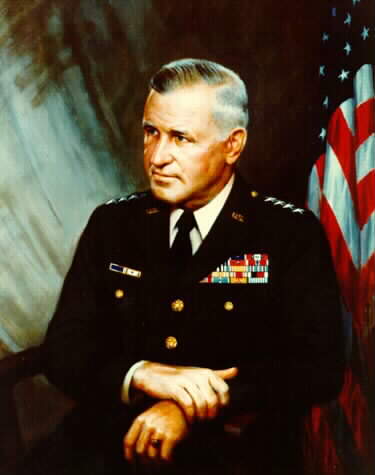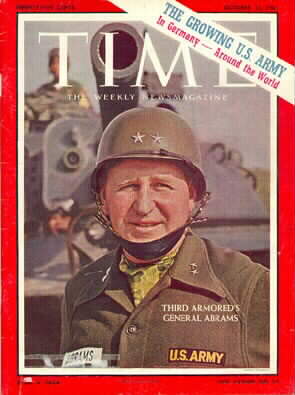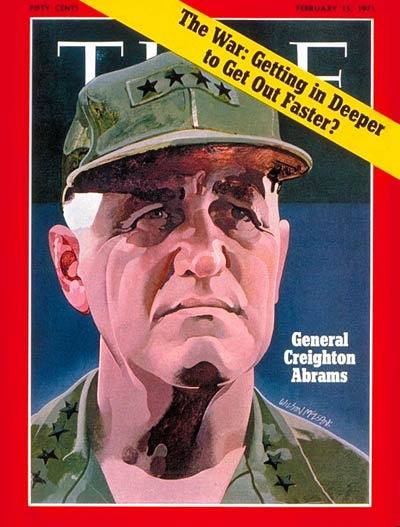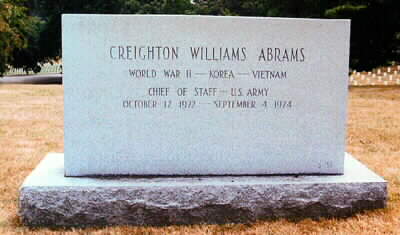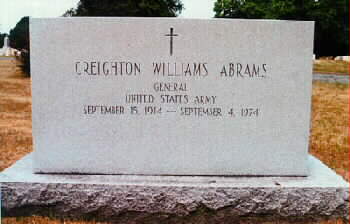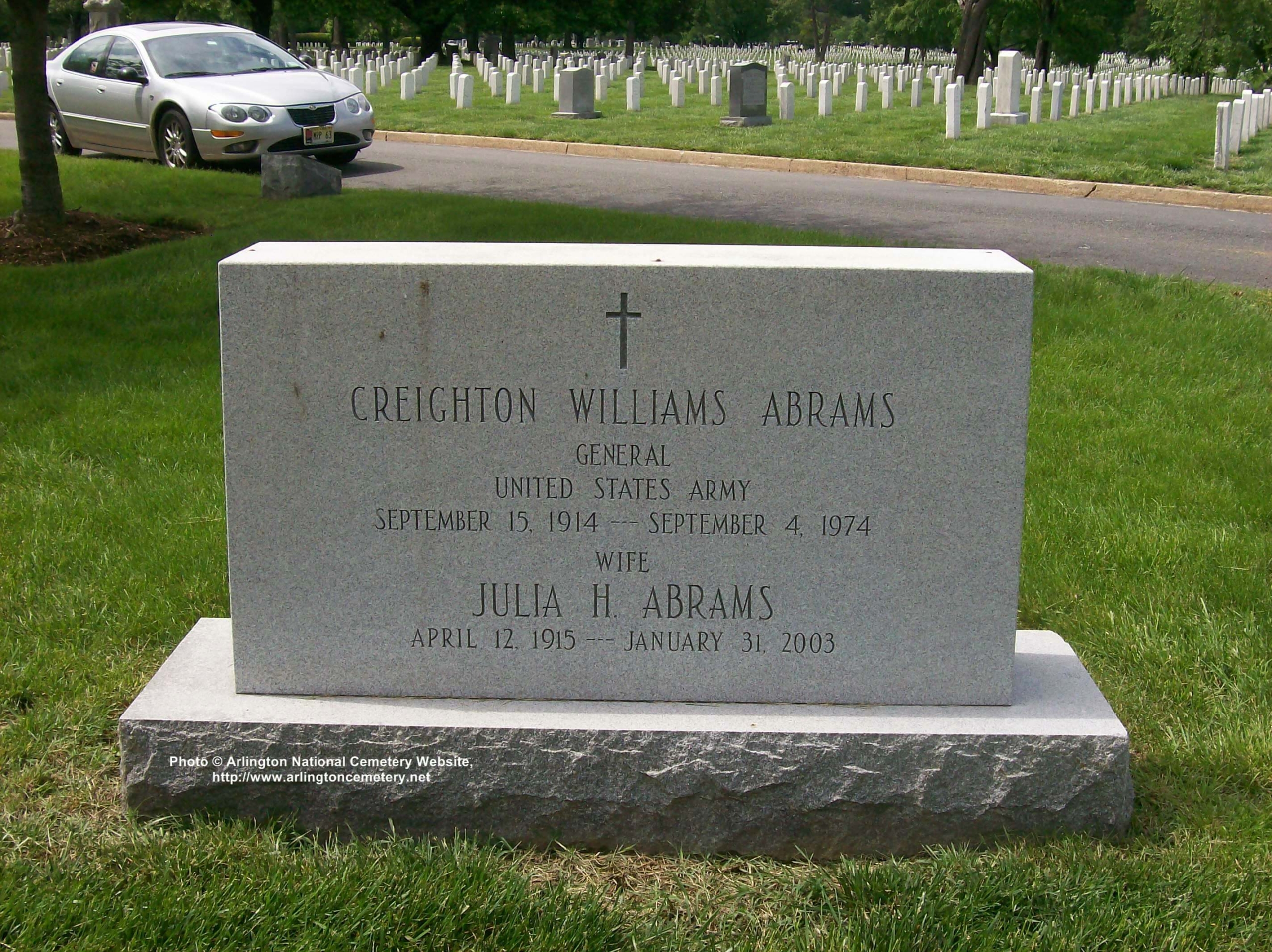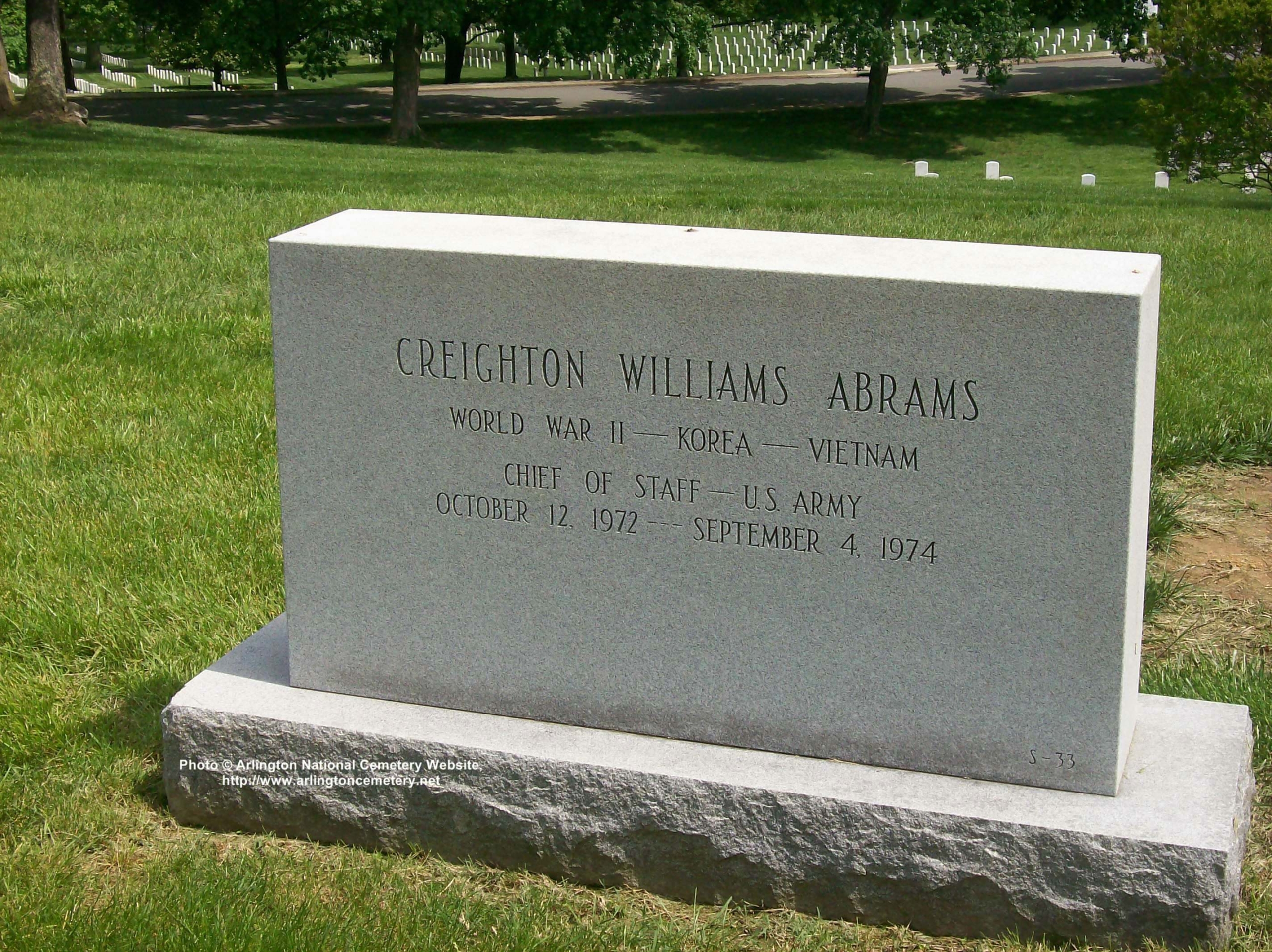Creighton Williams Abrams Jr. (Sep 15, 1914, Springfield, Massachusetts – Sep 4, 1974, Washington, D.C.) was a United States Army general who commanded military operations in the Vietnam War from 1968-72 which saw U.S. troop strength fall from 530,000 to 30,000. He served as Chief of Staff of the United States Army from 1972 until shortly before his death in 1974. In honor of Abrams, the U.S. Army named the XM1 main battle tank after him as the M1 Abrams.
He graduated from West Point in 1936 and served with the 1st Cavalry Division from 1936 to 1940, being promoted to first lieutenant in 1939 and temporary captain in 1940.
He became an armored officer early in the development of that branch and served as a tank company commander in the 1st Armored Division in 1940.
During World War II, he served with the 4th Armored Division, initially as regimental adjutant (June 1941 – June 1942) then as a battalion commander (July 1942 – March 1943), and regiment executive officer (March 1943 – September 1943) with the US 37th Armor Regiment. A reorganization of the division created a new battalion, the 37th Tank Battalion, which he commanded until March 1945 when he was promoted to command Combat Command B of the division. During this time he was promoted to the brevet ranks of Major (March 1943) and Lieutenant Colonel (September 1943).
During much of this time his unit was at the spearhead of the 4th Armored Division and the Third Army, and he was consequently well known as an aggressive armor commander. By using his qualities as a leader and by consistently exploiting the relatively small advantages of speed and reliability of his vehicles he managed to defeat German forces who had the advantage of superior armor, superior guns and better trained troops. He was twice decorated with the Distinguished Service Cross, second only to the Medal of Honor, for actions on September 9, 1944 and December 26, 1944.
On April 23, 1945, Will Lang Jr. wrote a biography called “Colonel Abe” for Life (magazine)
Abrams was known as an aggressive and successful armor commander. General George Patton said of him, “I’m supposed to be the best tank commander in the Army, but I have one peer: Abe Abrams. He’s the world champion.” His unit was frequently the spearhead of the Third Army during WWII. Abrams was one of the leaders in the relief effort which broke up the German entrenchments surrounding Bastogne and the 101st Airborne Division during the Battle of the Bulge.
He was noted for his concern for soldiers, his emphasis on combat readiness, and his insistence on personal integrity.
Following the war he served on the Army General Staff (1945 – 1946), as head of the department of tactics at the Armored School, Fort Knox (1946 – 1948), and graduated from the Command and General Staff College at Fort Leavenworth (1949). He was briefly promoted to (temporary) Colonel in 1945 but reverted to Lieutenant Colonel during WWII demobilization.
He commanded the 63d Tank Battalion, part of the 1st Infantry Division, in Europe (1949 – 1951). He was again promoted to Colonel and commanded the 2d Armored Cavalry Regiment (1951-1952). These units were important assignments due to the Cold War concern for potential invasion of western Europe by the Soviet Union. He then attended and graduated from the Army War College in 1953.
During his tenure in Germany he was on the cover of Time Magazine on October 13, 1961. He was to grace the covers again on April 19, 1968, and February 15, 1971.
Due to his service in Europe and his War College tour, he joined the Korean War late in the conflict. He successively served as chief of staff of the I, X, and IX Corps in Korea (1953-1954).
Upon return from Korea he served as Chief of Staff of the Armor Center, Fort Knox (1954-1956). He was promoted to Brigadier General and appointed Deputy Chief of Staff for Reserve Components at the Pentagon (1956-1959). He was Assistant Division Commander of 3rd Armored Division (1959 – 60) and then commanded the division (1960 – 62) upon his promotion to Major General.
He was then transferred to the Pentagon as deputy Chief of Staff for Operations (1962 – 63), then was promoted to lieutenant-general and commanded V Corps in Europe (1963 – 1964).
He was promoted to General in 1964 and appointed Vice Chief of Staff of the Army (he was seriously considered as a candidate for Chief of Staff at that time). Due to concerns about the conduct of the Vietnam War, he was appointed as deputy to General William Westmoreland, head of the Military Assistance Command in Vietnam, in May 1967. He succeeded Westmoreland as commander on June 10, 1968. His tenure of command was not marked by the public optimism of his predecessors, who were prone to press conferences and public statements.
Following the election of President Richard Nixon he implemented the Nixon Doctrine referred to as Vietnamization. Vietnamization was designed to wind down U.S. involvement in Vietnam, and have South Vietnam responsible for executing the war.
Troop strength under Abrams decreased from 535,000 in December 1968 to 140,000 in December 1971 to 30,000 combat troops at the end of 1972. Abrams was in charge of the Cambodian Incursion in 1970. Although it occurred before he assumed total command, he bore the brunt of fallout from the My Lai massacre in March 1968.
He was appointed Chief of Staff of the United States Army in June 1972 but was not confirmed by the Senate until October 1972 due to political repercussions involving disobedience by one of his subordinate commanders. (It has also been reported that Congress held up the confirmation to question the administration’s war in Cambodia.) He served in this position until his death due to complications from lung cancer surgery in September 1974. During this time he began the transition to the all-volunteer Army.
He was born in Springfield, Massachusetts, in 1914. His father was a railway mechanic and farmer.
Abrams married Canadian Julia Abrams (1915 – 2003) in 1936. She founded the “Arlington Ladies” and devoted a great deal of her time to humanitarian causes. They had three daughters and three sons. The sons all became Army officers, and all of the daughters married Army officers.
Survivors include three sons, retired Army Brigadier General Creighton Williams Abrams III of Springfield, retired Army General John Nelson Abrams of Annandale and Army Lieutenant Colonel Robert Bruce Abrams of Texas; three daughters, Noel Bradley of Buffalo, Jeanne Daley of Annandale and Elizabeth Doyle of Nashville; two sisters; 19 grandchildren; and six great-grandchildren.
He converted to Roman Catholicism while serving in Vietnam.
Abrams is buried with his wife in Section 21 of Arlington National Cemetery.
Distinguished Service Cross (2)
Distinguished Service Medal (3)
Born at Springfield, Massachusetts, September 15, 1914, General Abrams was the U.S. commander in the Vietnam War from 1968 to 1972.
A graduate (1936) of the United States Military Academy at West Point, he served in World War II and, following numerous other assignments, in 1964 became a full general and Vice Chief-of-Staff of the United States Army.
Succeeding William Westmoreland as overall military commander in Vietnam, he implemented a program known as Vietnamization. This was supposed to bring a gradual end to US involvement in Vietnam and to enable the South Vietnamese to become increasingly responsible for running the war. After returning to United States, he served from 1972 to 1974 as Army Chief-of-Staff.
He died in Washington, D.C. of lung cancer, September 4, 1974, the first army Chief-of-Staff to die in office.
He was buried with full military honors in a special plot in Section 21 of Arlington National Cemetery.
Courtesy of the United States Army:
Creighton Williams Abrams, Jr., was born in Springfield, Massachusetts, on 15 September 1914; graduated from the United States Military Academy, 1936; married Julia Harvey, 1936; was commissioned a second lieutenant and served in the 1st Cavalry Division, 1936–1940; was promoted to first lieutenant, June 1939, and to temporary captain, September 1940; was briefly a tank company commander in the 1st Armored Division, 1941; was a battalion commander in the 37th Armored Regiment, 1942–1943; was promoted to temporary major (February) and lieutenant colonel (September), 1943; commanded the 37th Tank Battalion and Combat Command B, 4th Armored Division, in Allied operations across Europe, 1943–1945; was promoted to temporary colonel, April 1945; served on the Army General Staff, 1945, and in the War Plans section of the Army Ground Forces headquarters, 1945–1946; was director of tactics of the Armored School at Fort Knox, 1946–1948; was promoted to permanent ranks of captain, June 1946, and major, July 1948; graduated from the Command and General Staff College at Fort Leavenworth, 1949; commanded the 63d Tank Battalion, 1st Infantry Division, United States Army, Europe, 1949–1951; was again promoted to temporary colonel after postwar reversion, June 1951; commanded the 2d Armored Cavalry, United States Army, Europe, 1951–1952; graduated from the Army War College, 1953; was successively chief of staff of the I, X, and IX Corps, United States Army Forces, Far East, Korea, 1953–1954; was chief of staff of the Armor Center at Fort Knox, 1954–1956; was promoted to temporary brigadier general, February 1956; was deputy assistant chief of staff for reserve components, 1956–1959; was assistant division commander of the 3d Armored Division, 1959–1960, and deputy chief of staff for military operations, United States Army, Europe, 1960; was promoted to temporary major general, June 1960, and permanent colonel, June 1961; was commander of the 3d Armored Division, 1960–1962; was assistant deputy chief of staff and director of operations, Office of the Deputy Chief of Staff for Operations, 1962–1963; was assistant chief of staff for force development, 1963; commanded V Corps in Germany, 1963–1964; was promoted to permanent brigadier general (February) and temporary lieutenant general (August), 1963; was acting vice chief of staff and vice chief of staff of the United States Army, August 1964–April 1967; was promoted to general, September 1964, and permanent major general, August 1965; was deputy commander and then commander of United States Military Assistance Command, Vietnam, 1967–1972; was chief of staff of the United States Army, 12 October 1972– 4 September 1974; supervised the Army in the closing stages of the Vietnam War, including withdrawal of American troops from the war zone, overall reductions in Army strength, elimination of the draft, transition to a volunteer status, and execution of a major reorganization; died of cancer in Washington, D.C., on 4 September 1974.
Portrait Courtesy of the U. S. Army
Center For Military History
Creighton Williams Abrams, Jr., was born in Springfield, Massachusetts, on 15 September 1914; graduated from the United States Military Academy, 1936; married Julia Harvey, 1936; was commissioned a second lieutenant and served in the 1st Cavalry Division, 1936–1940; was promoted to first lieutenant, June 1939, and to temporary captain, September 1940; was briefly a tank company commander in the 1st Armored Division, 1941; was a battalion commander in the 37th Armored Regiment, 1942–1943; was promoted to temporary major (February) and lieutenant colonel (September), 1943; commanded the 37th Tank Battalion and Combat Command B, 4th Armored Division, in Allied operations across Europe, 1943–1945; was promoted to temporary colonel, April 1945; served on the Army General Staff, 1945, and in the War Plans section of the Army Ground Forces headquarters, 1945–1946; was director of tactics of the Armored School at Fort Knox, 1946–1948; was promoted to permanent ranks of captain, June 1946, and major, July 1948; graduated from the Command and General Staff College at Fort Leavenworth, 1949; commanded the 63d Tank Battalion, 1st Infantry Division, United States Army, Europe, 1949–1951; was again promoted to temporary colonel after postwar reversion, June 1951; commanded the 2d Armored Cavalry, United States Army, Europe, 1951–1952; graduated from the Army War College, 1953; was successively chief of staff of the I, X, and IX Corps, United States Army Forces, Far East, Korea, 1953–1954; was chief of staff of the Armor Center at Fort Knox, 1954–1956; was promoted to temporary brigadier general, February 1956; was deputy assistant chief of staff for reserve components, 1956–1959; was assistant division commander of the 3d Armored Division, 1959–1960, and deputy chief of staff for military operations, United States Army, Europe, 1960; was promoted to temporary major general, June 1960, and permanent colonel, June 1961; was commander of the 3d Armored Division, 1960–1962; was assistant deputy chief of staff and director of operations, Office of the Deputy Chief of Staff for Operations, 1962–1963; was assistant chief of staff for force development, 1963; commanded V Corps in Germany, 1963–1964; was promoted to permanent brigadier general (February) and temporary lieutenant general (August), 1963; was acting vice chief of staff and vice chief of staff of the United States Army, August 1964–April 1967; was promoted to general, September 1964, and permanent major general, August 1965; was deputy commander and then commander of United States Military Assistance Command, Vietnam, 1967–1972; was chief of staff of the United States Army, 12 October 1972– 4 September 1974; supervised the Army in the closing stages of the Vietnam War, including withdrawal of American troops from the war zone, overall reductions in Army strength, elimination of the draft, transition to a volunteer status, and execution of a major reorganization; died of cancer in Washington, D.C., on 4 September 1974.
Courtesy of the United States Army
The Army’s Commemorative biography and photo are here used by permission of the United States Military Academy, West Point, N.Y.
4 September 1974
GENERAL CREIGHTON W. ABRAMS
Chief of Staff, United States Army
At 0035 today, General Creighton W. Abrams, Chief of Staff, United States Army, who had recently been described by Secretary of Defense James R. Schlesinger as “an authentic national hero,” died at Walter Reed Army Medical Center in Washington. The general re-entered the hospital for treatment of complications following earlier surgery to remove a cancerous left lung.
Born in Springfield, Massachusetts, General Abrams would have been sixty on September 15th. He had worn his country’s uniform for over forty-two years, for four years as a cadet at West Point, and for thirty-eight years as an Army officer.
A veteran of three wars, General Abrams rose to the Army’s highest leadership position because he was preeminently a leader and commander of troops, particularly in wartime. From platoon to corps, he commanded at every Level and finally served as Joint Commander of all U.S. Forces in Vietnam. Commissioned in the Cavalry in 1936, General Abrams served initially with various cavalry and tank units of the 1st Cavalry Division and the 1st Armored Division. Joining the newly activated 4th Armored Division in 1941, he remained with the Division throughout World War II. As a battalion commander, and then combat command commander, he participated in every campaign the Division fought and became widely known as one of the Army’s most aggressive and successful Armor commanders. It was Lieutenant Colonel Abrams, in a conference on the banks of the Moselle, who pointed east and remarked: “That is the shortest way home.” It was a tank unit called Task Force “Abe” that led the thrust across the Moselle; it was a tank unit commanded by Abrams that broke the German encirclement at Bastogne. It was Abrams’ unit that tore from Bitburg to the Rhine including an attack of over forty miles in less than two days. Time and time again Abrams led the thrust across the German homeland and into Czechoslovakia, often at the head of the column. His World War II commander, General George S. Patton, Jr., once said: “I’m supposed to be the best tank commander in the Army but I have one peer – Abe Abrams. He’s the world champion.”
The 4th Armored Division is now inactive, but its former members still meet from time to time. To these men, General Abrams was always one of them. At a 4th Armored Division Association convention last year, General Abrams was introduced to the gathering as “the Chief of Staff of the United States Army, Colonel Abe!”
During the Korean War, General Abrams served successively as Chief of Staff of I, IX and X Corps. He participated in the defense against the last major Communist offensives of the war. He remained to help set up I Corps as a key link in the United Nations Command organization.
Following his duty in Korea, General Abrams served for a period as Chief of Staff of the Armor Center at Fort Knox, Kentucky. Returning to Europe in 1959, he was assigned as Assistant Division Commander, 3d Armored Division, and later as Commanding General of the Division. After another tour in Washington and yet another in Europe, this time as a Corps Commander, he received his fourth star and was selected as the Army’s Vice Chief of Staff.
In 1967, he became Deputy Commander of the U.S. Military Assistance Command, Vietnam; a year later, he was appointed its Commander. For the four years General Abrams commanded in Vietnam, it was his task to reduce direct U.S. military involvement and to transfer increasing defense responsibilities to Vietnamese forces, as they became capable of assuming them. By the time he left Vietnam in 1972, that job had been virtually completed.
After his extensive service in Vietnam, General Abrams was nominated to be Chief of Staff, United States Army, and was confirmed by the Senate on October 12, 1972. Since that day, General Abrams’ principal challenge was to knit together an Army that had suffered the double trauma of rapid reduction in size and massive repositioning of forces, both occasioned by the end of U.S. military operations in Vietnam. To add to the challenge, it was during this same period that authority for induction ended, and the Army shifted to an all-volunteer footing.
The major themes in the Army during those two years were Abrams themes, as plain and strong as the man who established them: the readiness mission; rethinking the Army’s role; and taking care of the soldier. The actions that flowed from this guidance increased the readiness and effectiveness of the Army dramatically. At the same time, morale improved and disciplinary problems subsided, responding to the firm hand at the top. Just prior to his being stricken by lung cancer, General Abrams had set in motion a program to increase markedly the Army’s combat capability without increasing its total strength. It was to be done the Abrams way, by cutting out entire headquarters, by making other headquarters – including his own – much smaller, and by making every element in the Army count toward the overall mission.
Direct and plain-spoken, General Abrams liked being around soldiers and was approachable by soldiers of all ranks. He understood them, and they respected and admired him. He was equally respected by his civilian superiors and by Members of Congress. Secretary of the Army Howard H. Callaway referred to him as “our number one soldier.” Senator John C. Stennis, Chairman of the Senate Armed Services Committee, made reference to General Abrams as “a real soldier . . . I always thought of him as having mud on his boots.” Senator Sam Nunn, another member of the Armed Services Committee, referred to him as “a great soldier.”
His military superiors also thought highly of General Abrams as he assumed positions of increasing responsibility. When Brigadier General Abrams was a young Assistant Division Commander in Europe in the early sixties, his Division Commander wrote: ” . . . he has attained a rare balance between his natural characteristics of a colorful, decisive, driving commander and a calculating, canny, thorough planner . . . He knows soldiers as few men do and has no peer as an armored leader.”
Abrams as Division Commander was, if anything, even more highly praised. According to his Corps Commander, “. . he is the outstanding armor commander of his generation . . He is open, honest, frank, sincere, completely dedicated to the Army and the highest ideals of service . . . He is tactful but firm.”
Throughout his subsequent career, General Abrams was repeatedly evaluated in terms such as “unequalled,” “without peer,” “the best.” That he became Chief of Staff of the Army surprised none of those officers under whom he served.
Preferring to remain as far from the public eye as possible, he was well-known to the public and sought by the media, largely as a result of his straightforward, candid way of conducting the public’s military business.
General Abrams was a private person, by preference. He enjoyed listening to classical music at home, and just being with his family. He tended to limit his public appearances and speech-making, but people liked to hear him talk. He had a modest, but well-polished, collection of stories, many of them autobiographical, at least in spirit. His favorite stories tended to hark back to earlier days, to the era when he played football at West Point and to his early cavalry days. The messages he brought to the military and civilian groups he talked to reflected the basic ideas he felt most strongly about: the safety of the Nation; the need for the Army to be ready, and the dreadful human costs of unpreparedness; the importance of simple integrity; and the needs the paramount needCof remembering the soldier and his immediate leaders, the people at the end of a long chain of command.
General Abrams is survived by his wife, the former Julia Harvey, and by their children; Noel, Creighton Jr., John, Jeanne, Elizabeth, and Robert Bruce. He is also survived by a sister, Bette (Mrs. William L.) James of Feeding Hills.
Interment will be in Arlington National Cemetery.
AS THE HOMETOWN KNEW HIM
When Creighton Abrams was a small boy, the family moved to Feeding Hills and after living in several rented locations, built a home on North Westfield Street. The father, Creighton Abrams Sr., worked as a repairman for the Boston & Albany Railroad and was interested in all the activities of a very busy son. Creighton was involved in 4-H Club work, raising baby beef and pigs and in 1929 was selected to represent the Hampden County boys at Camp Field at Brockton Fair. A local 4-H leader recalls the day in the summer of 1927 when she and Otis Hall, County Director, visited the Abrams home. Creighton was not there and his mother remarked ruefully that he seemed to be giving up 4-H for other interests. Mr. Hall responded with his usual eager enthusiasm, “We’re not trying to make farmers out of all these boys. We don’t care how many hogs or cabbages he raises; it’s the boy we’re interested in. We’re trying to build self-reliance, good judgment and character. For many, 4-H is a stepping stone.”
At school, Creighton was a good student and his teachers remember him as a dependable boy of firm character. In his spare time he trapped muskrats, an activity in which he was usually accompanied by his dog. He patched a wheezing Model T, learned to shoot by drilling holes with his .22 through tin cans tossed up by his father, and played his favorite sport, football. In 1931, he was captain and center of Agawam High School’s football team through an unbeaten, untied and unscored-upon season. Creighton was described in his class yearbook as the “loudest, happiest, fightinest man on the team.”
He was on the staff of the Agawam Mirror, Class officer, Student Council, Pro Merito and other activities. He was voted the best all-around boy and the most likely to succeed.
The class prophecy in the yearbook of 1932 says: “And didn’t you get a thrill last week when you read the headlines ‘Major General Abrams Leads Attack on Russian Revolutionists.’ “
Creighton Abrams was Army-oriented even then. His speech as class orator started with the fact that the date was the two hundredth anniversary year of the birth of George Washington, “the man who as a boy led his playmates in mimic battles and as a man led a nation in a dreadfully real war.”
To illustrate the High School’s ability to win over larger schools, he told of a battle in ancient history where a small army won over a large one, and he seemed to be thinking even then in terms of tactics.
Agawam High School Football team. Back row, Benoit, Provost, Jones, Tisdel. Front Mosely, Pond Roberts, Abrams, Parent, Ray mond In the same address, he spoke to the school staff, “You will take this High School system through this period of depression just as Washington led his Army through the winter at Valley Forge with a clear head and a confident spirit.”
When the hoped-for appointment to West Point came through, Creighton was so jubilant that he rushed out of the school and seeing his sister, picked her up and whirled her about in dizzying circles yelling, “I got it, I got it!”
He was soon sobered by the realization that he would have to have $300 in order to start life as a cadet. Due to the depression, his father was working only part time and that was a very large sum. School Superintendent Benjamin Phelps told him to go and see Mrs. Minerva Davis. Although the errand was not to his liking, he went. Mrs. Davis loaned him the $300, which he paid back after graduation from West Point.
In 1939, as Lieutenant Abrams, he was speaker at a High School assembly and made a lasting impression on the students.
Years later, when he took command of the 3rd Armored, he moved to Germany with his wife and four of their six children. He stated that “if there is going to be trouble I prefer to be right there. This is the job I want.”
Agawam people were glad that a man like Creighton Abrams was out there on the job during the war, and are proud to have known him during those early years of his life.
ABRAMS, CREIGHTON WILLIAMS, JR.
(First Award)
Citation:
The President of the United States takes pleasure in presenting the Distinguished Service Cross to Creighton Williams Abrams, Jr. (0-20296), Lieutenant Colonel, U.S. Army, for extraordinary heroism in connection with military operations against an armed enemy while serving as Commanding Officer of the 37th Tank Battalion, 4th Armored Division, in action against enemy forces on 20 September 1944, when two of his tank companies were out-flanked and seriously disorganized by an armored attack of superior forces.
Quickly and accurately estimating the situation, Lieutenant Colonel Abrams unhesitatingly attacked the enemy force with his command tank, striking with such ferocity that the enemy was thrown into a state of confusion and his own forces were able to regroup. Lieutenant Colonel Abrams then daringly led his reorganized companies in a frontal assault which resulted in the complete rout of the enemy and the capture of a valuable position with a considerable amount of enemy supplies. His rapid and heroic action, undertaken with great initiative and brilliant leadership, was largely responsible for the successful action and was an inspiration to all who witnessed it.
Lieutenant Colonel Abrams’ intrepid actions, personal bravery and zealous devotion to duty exemplify the highest traditions of the military forces of the United States and reflect great credit upon himself, the 4th Armored Division, and the United States Army.
Headquarters, U.S. Army Forces in the Far East, General Orders No. 66 (1943)
ABRAMS, CREIGHTON WILLIAMS, JR.
(Second Award)
Citation:
The President of the United States takes pleasure in presenting a Bronze Oak Leaf Cluster in lieu of a Second Award of the Distinguished Service Cross to Creighton Williams Abrams, Jr. (0-20296), Lieutenant Colonel, U.S. Army, for extraordinary heroism in connection with military operations against an armed enemy while serving as Commanding Officer of the 37th Tank Battalion, 4th Armored Division, in action against enemy forces on 26 December 1944, when he led his battle-weary battalion in an assault on a heavily defended town.
When the advance was held up by a concealed enemy anti-tank gun, Lieutenant Colonel Abrams went forward in his command tank and destroyed the gun; his example inspiring his men to press on and take the town. Then, heedless of approaching darkness and strong enemy defenses, he brilliantly led his battalion on to a further objective.
Lieutenant Colonel Abrams’ intrepid actions, personal bravery and zealous devotion to duty exemplify the highest traditions of the military forces of the United States and reflect great credit upon himself, the 4th Armored Division and the United States Army.
Headquarters, Third U.S. Army, General Orders No. 43 (1945)
From a contemporary press report:
Julia Abrams, 87, a civic volunteer who was the widow of former Army Chief of Staff General Creighton W. Abrams Jr., died of congestive heart failure and emphysema January 31, 2003, at Walter Reed Army Medical Center. She lived in Annandale.
She had been married to General Abrams for 38 years until his death in 1974. They met while he was a cadet at the U.S. Military Academy at West Point and she was a junior at Vassar College.
They married in the summer of 1936 after she graduated with a degree in English literature. An armored officer, he commanded a tank battalion in the Third Army during World War II and was promoted to four-star general in 1964. He went on to serve as U.S. commander in Vietnam from 1968 to 1972, when he was named Army Chief of Staff.
Mrs. Abrams accompanied her husband to overseas assignments and lived in Germany and Thailand.
In the early 1970s, at the suggestion of her husband, she founded the Arlington Ladies, a group of mostly women who attend graveside internment services at Arlington National Cemetery. She recruited members from among Army officers’ wives and helped train them in military protocol, writing notes of condolence and offering support.
Mrs. Abrams, who was born in Drummondville, Quebec, was honorary chairman of the Arlington Ladies, honorary first lady of the U.S. Armor Association, a member of the executive council of the National Girl Scouts of America and a member of the National Military Families Association. She also had done volunteer work for Mitradab, a Thai-U.S. foundation chartered for school construction in rural Thailand.
Survivors include three sons, retired Army Brigadier Gen. Creighton Williams Abrams III of Springfield, retired Army General John Nelson Abrams of Annandale and Army Lieutenant Colonel Robert Bruce Abrams of Texas; three daughters, Noel Bradley of Buffalo, Jeanne Daley of Annandale and Elizabeth Doyle of Nashville; two sisters; 19 grandchildren; and six great-grandchildren.
Of Annandale, Virginia on Friday, January 31, 2003. JULIA H. ABRAMS, beloved wife of the late General Creighton W. Abrams, (USA). Loving and devoted mother to Noel Bradley, Creighton W. Abrams Jr. (BG USA Ret.), John N. Abrams (General USA RET.), Jeanne R. Daly, Elizabeth Abrams Doyle, Robert Bruce Abrams (Lt. Col. USA); sister of Dr. Rejane M. Harvey and Jean Hickey. Also surviving are 19 grandchildren and six great-grandchildren.
Friends may call at the THE MURPHY FUNERAL HOME OF ARLINGTON, 4510 Wilson Blvd., on Monday, February 10 from 2 to 5 p.m. Mass of Christian Burial will be celebrated on Tuesday, February 11 at 9:45 a.m. in Ft. Myer Memorial Chapel. Interment Arlington National Cemetery. It is suggested that memorial contributions be made in her name to the Army Distaff Foundation, 6200 Oregon Ave., NW, Washington, DC 20015.
ABRAMS, CREIGHTON W
GEN US ARMY
- DATE OF BIRTH: 09/15/1914
- DATE OF DEATH: 09/04/1974
- BURIED AT: SECTION 21 SITE S-33
- ARLINGTON NATIONAL CEMETERY
ABRAMS, JULIA H
- DATE OF BIRTH: 04/12/1915
- DATE OF DEATH: 01/31/2003
- BURIED AT: SECTION 21 SITE S-33
- ARLINGTON NATIONAL CEMETERY
- WIFE OF ABRAMS, CREIGHTON W GEN US ARMY
Michael Robert Patterson was born in Arlington and is the son of a former officer of the US Army. So it was no wonder that sooner or later his interests drew him to American history and especially to American military history. Many of his articles can be found on renowned portals like the New York Times, Washingtonpost or Wikipedia.
Reviewed by: Michael Howard


